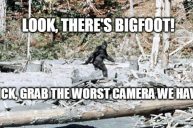Creatures like Big Foot and The Lock Ness Monster have captivated the public's interest for years. Sightings have been reported by many people but are they factual? What is the truth behind the mysteries of these famous creatures? Scientists have recently revealed the likely truth behind the Loch Ness Monster.
The Likely Truth Behind The Loch Ness Monster

Shutterstock Photo
The NY Post shared that a "Scottish naturalist who has investigated the Loch Ness Monster mystery for a half-century believes there is some fowl play when it comes to sightings of the perplexing plesiosaur." He argues that the only long-necked creatures in the lake are swans.
Although he has been researching the elusive Loch Ness Monster for 50 years, he remains a "sympathetic skeptic" regarding its existence. However, the public has steadfast belief. With over 1,156 "official" reports of sightings people thoroughly believe in the existence of this elusive creature.
The naturalist shared that boat wakes are most likely the main cause of the mythical creature sightings. He continued, "And in calm conditions, you can lose your ability to judge distance, and if you can't judge distance, you can't judge size."
However boats are not the only thing confused for this creature. Birds are also a common culprit. His theory is supported by many photos that show the likeness between swans and the infamous creature. However swans are not the only possible culprits. Cormorants and mergansers are also often mistaken as the Loch Ness Monster.
Mythical Creature Or Boat Wakes?
Besides birds with long necks, the naturalist believes that "boat wakes could form the iconic 'humps' seen in photographs." He told the Post, "When a vessel is coming towards you , it is obvious what the wake is." However, "if it is going across your front, it's quite different - you see the individual wave train, the individual wavelengths, as solid black humps."
Therefore, this could create the illusion of continuous humps. Furthermore, sea serpents are also a common misconception. The Loch Ness Monster doppelgangers include "sturgeon, catfish and giant eels." Anytime someone sees something they do not recognize, they assume it is the mythical creature.
Finally, the naturalist argues that a creature as large as Nessie would need a substantial amount of food. More food than the loch could provide it. He claimed, "The sea is too big for people to really argue about, whereas the loch represents a finite environment, more amenable to resolution." With all of the mounting evidence, it seems that the Loch Ness Monster is more of a common curiosity than a real-life creature.




